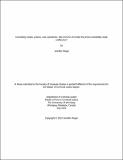| dc.contributor.author | Weger, Jennifer | |
| dc.date.accessioned | 2022-07-26T19:44:28Z | |
| dc.date.available | 2022-07-26T19:44:28Z | |
| dc.date.issued | 2022-07-26 | |
| dc.identifier.citation | Weger, Jennifer. Invisibility cloaks, prisons, and a pandemic: Did COVID-19 render the prison invisibility cloak ineffective? A thesis submitted to the Faculty of Graduate Studies in partial fulfilment of the requirements for the Master of Criminal Justice degree, The University of Winnipeg. Winnipeg, Manitoba, Canada: University of Winnipeg, July 2022. DOI:
10.36939/ir.202207261438. | en_US |
| dc.identifier.uri | https://hdl.handle.net/10680/2009 | |
| dc.description.abstract | This thesis acknowledges the importance of examining news media representation of prisons, and more specifically, news media representation of Canadian prisons during the COVID-19 pandemic. A thematic qualitative and quantitative content analysis of news coverage of prison before and during the COVID-19 pandemic was undertaken to analyze how news media organizations communicate meanings and messages about punishment and prison to the general public. Utilizing a social constructionist approach, I examined how the news media frames coverage of correctional institutions, consequently shaping public understanding of punishment and prison which may impact correctional policy. This thesis addressed the following questions: 1) Was there an increase in news media coverage of prison during the COVID-19 pandemic? Has coverage during the COVID-19 pandemic made the prison more visible? 2) Does the news media coverage of correctional institutions during the COVID-19 pandemic reinforce traditional myths and stereotypes surrounding punishment and prison? Or challenge them? 3) Is the news media representation of correctional institutions during the COVID-19 pandemic consistent with coverage of traditional prison newsworthy items which focus on discrete incidents? Or does the coverage reflect newer, broader systemic newsworthy issues, namely, reform? The findings demonstrate that the COVID-19 pandemic did not quantitatively bring more visibility to prisons as assessed by the amount of news items, however, qualitatively it appears COVID-19 brought more visibility to prison issues. While some traditional prison stereotypes are still present in the news media and were reinforced during the pandemic, other myths and stereotypes were challenged, or were rare. Lastly, the results demonstrate that although traditional prison newsworthy items were still often reported in the news, discussions of prison reform were prevalent in the sample. | en_US |
| dc.language.iso | en | en_US |
| dc.publisher | University of Winnipeg | en_US |
| dc.rights | info:eu-repo/semantics/openAccess | en_US |
| dc.subject | Prisons | en_US |
| dc.subject | Correctional insitutions | en_US |
| dc.subject | COVID-19 | en_US |
| dc.subject | Pandemics | en_US |
| dc.subject | News media | en_US |
| dc.title | Invisibility cloaks, prisons, and a pandemic: Did COVID-19 render the prison invisibility cloak ineffective? | en_US |
| dc.type | Thesis | en_US |
| dc.description.degree | Master of Criminal Justice | en_US |
| dc.publisher.grantor | University of Winnipeg | en_US |
| dc.identifier.doi | ____ | en_US |
| dc.identifier.doi | 10.36939/ir.202207261438 | |
| thesis.degree.discipline | Criminal Justice | |
| thesis.degree.level | masters | |
| thesis.degree.name | Master of Criminal Justice | |
| thesis.degree.grantor | University of Winnipeg | |

